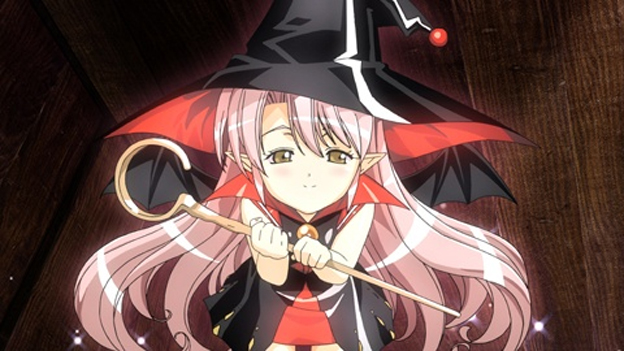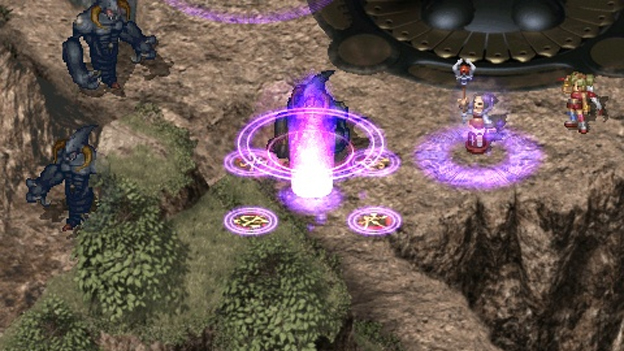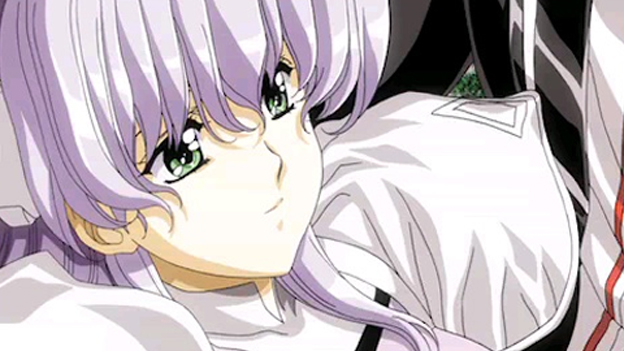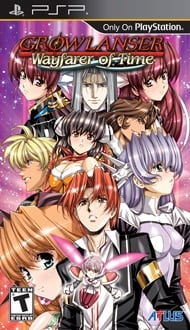Fighting Angels, Changing Fates
The Growlanser series isn’t one of the best-known JRPG franchises in North America, but it has a very dedicated core of fans. When Atlus announced that it would be bringing over an enhanced PSP port of Growlanser IV, originally a PlayStation 2 game that was only released in Japan, the English-speaking Growlanser community was pleased indeed. I’ve been curious about the series for a while, and was myself pleased to give it a first spin with this game, which has been titled Growlanser: Wayfarer of Time in English.
It doesn’t take long for fans of epic fantasy and political intrigue to get into Growlanser: Wayfarer of Time’s story. The custom-named protagonist (we’ll call him Hero, because his default name seems more fitting for a fruity beverage) begins the story as an orphan who has been raised by a mercenary band, but it isn’t long before he’s off on his own adventure after mysterious Angels begin attacking humanity. Naturally, Hero has special powers, and finds himself a pawn between warring political powers as he attempts to learn why he’s supposedly the key to stopping the Angels and saving the world.

Growlanser’s campaign is lengthy and its story compelling. There’s a great mix here between world-spanning conflict and the smaller, individual stories of the characters that Hero meets along the way. The nations of Growlanser’s world are complex and interesting, playing host to both kind and cruel leaders no matter what kind of government controls them. Although Hero will often encounter the worst humanity has to offer along his journey, experiencing many tragedies, there’s always a ray of hope provided via characters who demonstrate courage and human kindness. Through good times and bad, the story generally moves at a brisk pace, compelling continued play in order to see what happens next.
As usual in JRPG worlds in crisis, terrifying monsters have begun to proliferate in Growlanser’s world, and while the nations blame the monster appearances on each other, somebody has to actually take care of business. That somebody is Hero, and fortunately the game provides an entertaining battle system with which the player’s party dispatches both monstrous and human threats. It’s a mash-up of turn-based and real-time combat that gives the player plenty of control, but keeps the action moving along when input isn’t necessary. The player can pause the battle at any time to issue new orders, but otherwise the battle will only pause when a character’s target is dead. It’s even possible to order the party to go all-out in combat, attacking whatever is nearby, so only Hero needs to be given direct orders.

Magic forms a vital part of combat, and Growlanser features a deep, highly customizable magic system. Each character equips a magic ring, which manifests itself into a weapon and can also be slotted with spellstones. A wide variety of these stones are available throughout the game, teaching various spells and abilities to characters once they’re slotted into a ring. Later on, the player learns to link spells together, creating area-affect attacks and other powerful effects. The system can feel a bit too complex and overwhelming at first, but players will grow into it as the game progresses.
Although there are plenty of small battles with creatures out in the world, the main focus of the battle system is on the plot critical “mission” battles that are interspersed regularly through the game. Missions have a variety of win conditions, and many require the player to make use of the environment as well as simply killing foes. These battles provide a refreshing amount of challenge, and players should expect to fail, reload, and repeat a number of them. Sometimes this is because the mission requirements aren’t as clear as they should be, but often it’s simply a case of needing to use a stronger strategy in order to secure victory. Most of the missions won’t cross the line from challenging to frustrating, and the variety of goals keep the game interesting throughout.

There’s plenty to do in the game beyond battles, however. Unusual for the genre, Growlanser features dialogue and storyline choices that actually matter. Although the main storyline is fairly linear, Hero’s dialogue choices determine which of his companions he becomes closest to, which in turn determines which of the game’s 40+ endings the player receives. He has plenty of opportunities to be a real jerk (sometimes hilariously so) if the player desires, though that’s not likely to advance him far in the affections of his teammates. There are also numerous characters whose fates Hero can change depending on the actions he takes in the game. If he takes the right actions, the characters survive and Hero has the chance to view the dire fight from which he saved them. Fail to take certain actions, and characters, sometimes rather important ones, will perish. This provides the game with a good measure of replay value, as the player returns to the story to see who can be saved by making different choices.
Because Growlanser’s character system has dating simulation elements, the game adheres to certain tropes that can make its approach to relationships seem less mature than the rest of the story. A few female characters seem unduly obsessed with Hero’s opinion of them, though later in the game most of them manage to grow into characters with their own motivations and interests. There are some rather unnecessary breast shots in places, and some creepy undertones in the character’s relationship with his fairy-like Familiar, things I found the game would have been better off without. The good news is that there’s a wide variety of characters available to build relationships with, so the player can choose to become close to stronger female characters or to male party members, if desired. The relationship system is a bit like the Persona series, in that not all important relationships are romantic, and there’s a strong variety in the romantic options available.
Beyond building relationships, there are numerous minor and side activities found in the game. There’s a small city to build, a decent number of side quests to experience, and even a few collections to accrue, such as outfits for the Familiar and a set of collectable cards. Collecting spellstones and building up character abilities is another satisfying activity. The game provides plenty of windows of time in which the player can choose to engage in these optional side activities or continue the main plot—though taking the time to thoroughly explore and engage in side quests is rewarded by opportunities to change character fates and build up strength for the difficult battles ahead.
Although the game’s battle controls are generally easy to use, the interface is a bit dated, which makes things like the spell and ability system appear more obtuse than they actually are. A few important system mechanics are easy to miss as well. For instance, when the player needs to ask an NPC about an item, that item should be used while standing next to the NPC. Knowing this can save the player from a rather tragic event partway through the game. Also, “buff” spells like increased attack can be cast outside of battle, and buffing up the party prior to missions becomes a near-requirement in the late game. A few tutorial segments can be reviewed by using books in the character’s “key items” menu, but for tricky elements like this, a more thorough help section would have been useful.

One area in which Growlanser doesn’t excel is its aesthetics, which are competent but not spectacular. The particular style used in the character designs leaves a lot to personal taste. Some people will appreciate them, even with the hairstyles that are frequently, like, totally Eighties. Others will be turned off by the sameness in the characters’ faces and other eccentricities of the style. Most players should appreciate the visual style of the cities in the game, which is quite ornate and often very interesting. The wilderness and dungeon design are less inspired, though the variety of puzzles in the dungeons at least keeps interest up during exploration.
The music and sound effects in the game aren’t particularly interesting, and voice acting is only found in cutscenes, where it appears without subtitles. This is a major no-no in the portable world, as headphone-less players will find themselves frantically pounding the PSP’s “volume up” button when a cutscene appears, losing the dialogue for the first several seconds. It doesn’t help that the rest of the game’s audio simply isn’t compelling enough to inspire headphone use, especially as the background music loops endlessly even when the game is paused.
The so-so aesthetics shouldn’t turn players away from this game, however, as it is very much worth experiencing. Growlanser: Wayfarer of Time is an excellent JRPG with a serious storyline and lots of juicy political intrigue. The battles are interesting and different from the norm, providing the kind of challenge that many RPG veterans crave. With a maturity to its story and an unusual amount of choice for the genre, the game will appeal not only to traditional JRPG fans, but to WRPG players and gamers who cross over into the genre for games like the Persona series. Growlanser is Vita-compatible and available on the PlayStation Network, so it will hopefully find an audience beyond the dwindling pool of PSP owners. Gamers with the ability to play it should definitely pick it up, as it’s a game the deserves to be experienced.
RATING OUT OF 5 RATING DESCRIPTION 3.4 Graphics
Interesting and detailed in towns, the graphics are less compelling outdoors, and the character art is a matter of personal taste. 3.9 Control
Battles are varied and challenging, and the deep magic system worth learning. The dated interface mars the experience slightly. 2.5 Music / Sound FX / Voice Acting
The music and sound are unremarkable, and the lack of a subtitle option in cutscenes is annoying. 4.5 Play Value
With a lengthy, compelling story, a variety of endings, and a number of optional activities to engage in, Growlanser is a meaty and fulfilling JRPG to play. 4.0 Overall Rating – Great
Not an average. See Rating legend below for a final score breakdown.
| Review Rating Legend | |||
|---|---|---|---|
| 0.1 – 1.9 = Avoid | 2.5 – 2.9 = Average | 3.5 – 3.9 = Good | 4.5 – 4.9 = Must Buy |
| 2.0 – 2.4 = Poor | 3.0 – 3.4 = Fair | 4.0 – 4.4 = Great | 5.0 = The Best |
Game Features:
